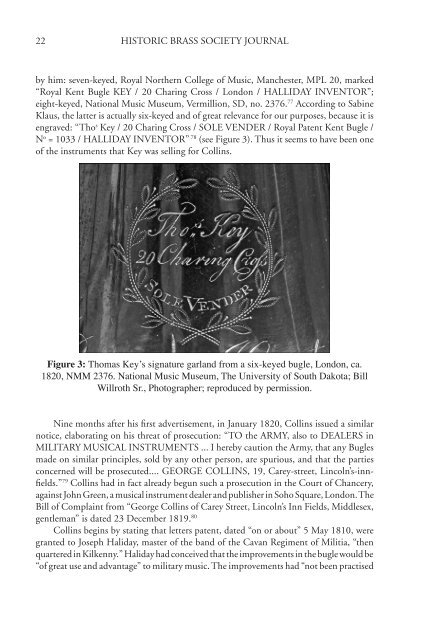New Light on the Early History of the Keyed Bugle Part I: The Astor ...
New Light on the Early History of the Keyed Bugle Part I: The Astor ...
New Light on the Early History of the Keyed Bugle Part I: The Astor ...
You also want an ePaper? Increase the reach of your titles
YUMPU automatically turns print PDFs into web optimized ePapers that Google loves.
22<br />
HISTORIC BRASS SOCIETY JOURNAL<br />
by him: seven-keyed, Royal Nor<strong>the</strong>rn College <strong>of</strong> Music, Manchester, MPL 20, marked<br />
“Royal Kent <strong>Bugle</strong> KEY / 20 Charing Cross / L<strong>on</strong>d<strong>on</strong> / HALLIDAY INVENTOR”;<br />
eight-keyed, Nati<strong>on</strong>al Music Museum, Vermilli<strong>on</strong>, SD, no. 2376. 77 According to Sabine<br />
Klaus, <strong>the</strong> latter is actually six-keyed and <strong>of</strong> great relevance for our purposes, because it is<br />
engraved: “Tho s Key / 20 Charing Cross / SOLE VENDER / Royal Patent Kent <strong>Bugle</strong> /<br />
N o = 1033 / HALLIDAY INVENTOR” 78 (see Figure 3). Thus it seems to have been <strong>on</strong>e<br />
<strong>of</strong> <strong>the</strong> instruments that Key was selling for Collins.<br />
Figure 3: Thomas Key’s signature garland from a six-keyed bugle, L<strong>on</strong>d<strong>on</strong>, ca.<br />
1820, NMM 2376. Nati<strong>on</strong>al Music Museum, <strong>The</strong> University <strong>of</strong> South Dakota; Bill<br />
Willroth Sr., Photographer; reproduced by permissi<strong>on</strong>.<br />
Nine m<strong>on</strong>ths after his first advertisement, in January 1820, Collins issued a similar<br />
notice, elaborating <strong>on</strong> his threat <strong>of</strong> prosecuti<strong>on</strong>: “TO <strong>the</strong> ARMY, also to DEALERS in<br />
MILITARY MUSICAL INSTRUMENTS ... I hereby cauti<strong>on</strong> <strong>the</strong> Army, that any <strong>Bugle</strong>s<br />
made <strong>on</strong> similar principles, sold by any o<strong>the</strong>r pers<strong>on</strong>, are spurious, and that <strong>the</strong> parties<br />
c<strong>on</strong>cerned will be prosecuted.... GEORGE COLLINS, 19, Carey-street, Lincoln’s-innfields.”<br />
79 Collins had in fact already begun such a prosecuti<strong>on</strong> in <strong>the</strong> Court <strong>of</strong> Chancery,<br />
against John Green, a musical instrument dealer and publisher in Soho Square, L<strong>on</strong>d<strong>on</strong>. <strong>The</strong><br />
Bill <strong>of</strong> Complaint from “George Collins <strong>of</strong> Carey Street, Lincoln’s Inn Fields, Middlesex,<br />
gentleman” is dated 23 December 1819. 80<br />
Collins begins by stating that letters patent, dated “<strong>on</strong> or about” 5 May 1810, were<br />
granted to Joseph Haliday, master <strong>of</strong> <strong>the</strong> band <strong>of</strong> <strong>the</strong> Cavan Regiment <strong>of</strong> Militia, “<strong>the</strong>n<br />
quartered in Kilkenny.” Haliday had c<strong>on</strong>ceived that <strong>the</strong> improvements in <strong>the</strong> bugle would be<br />
“<strong>of</strong> great use and advantage” to military music. <strong>The</strong> improvements had “not been practised

















